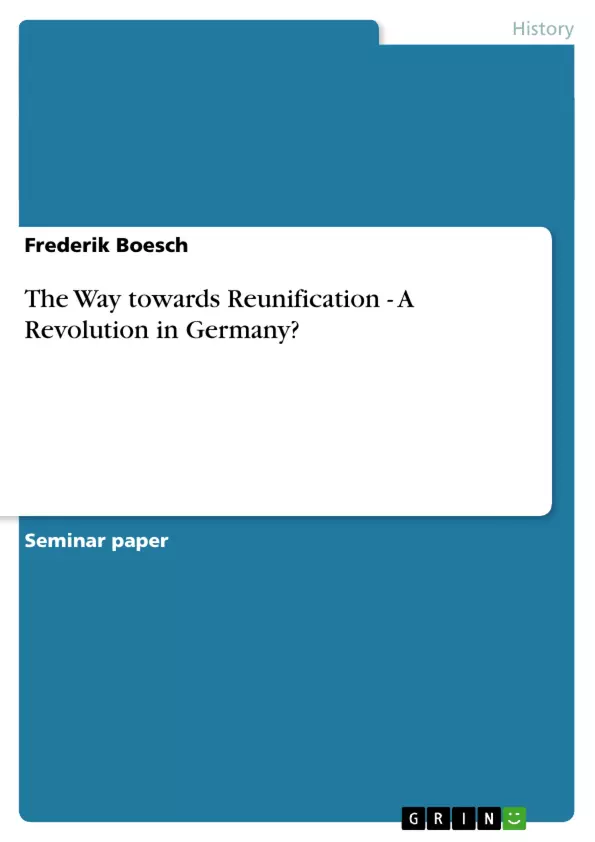The Way towards Reunification – A Revolution in Germany?
If you had asked a person on the street 16 years ago how reasonable he thought reunification of Western and Eastern Germany was, he would have probably laughed at you. However, only one year later, at the end of 1989, reunification was all of the sudden back on the agenda and discussed everywhere around the world. Within less than a year the GDR went through its most severe crisis from which it would never recover. Political scientists and historians would not have imagined that the GDR could dissolve so easily and so quickly. Thousands of citizens were fleeing to the West and literally hundreds of thousands were protesting in the streets of Leipzig and Berlin. The regime was internally divided and had no power to withstand the forces that were bringing its end. About a decade and a half later historians are still discussing the events that led to the dissolution of the GDR regime and are divided about the question whether it can be classified as a revolution or not. In my essay I will start out by looking at the weaknesses that the GDR regime had. There had to be a precondition that made the decline of East Germany possible and I will investigate that. Afterwards I will take a look at three different phases that the upheaval in 1989/90 had, namely the flight, the mass protests, and the Round Table talks. At the end of the paper I will discuss arguments in favour and against the notion that the GDR upheaval was a revolution and conclude with my own evaluation. Most of this essay is based on the book Dissolution by Charles S. Mayer (1997) and a chapter from the book The Rush to German Unity written by Konrad H. Jarausch (1994). Please note that I will most of the time refer to an “upheaval” when I describe the events in the GDR in 1989/90. I will try to avoid the term “revolution” in order to not take any position in favour of or against one historical camp or the other.
[...]
Inhaltsverzeichnis (Table of Contents)
- The Way towards Reunification - A Revolution in Germany?
- Weaknesses of the GDR Regime
- Three Phases of the Upheaval
- The Flight
- The Mass Protests
- The Round Table Talks
- Arguments for and against the Notion of Revolution
Zielsetzung und Themenschwerpunkte (Objectives and Key Themes)
This essay aims to explore the collapse of the German Democratic Republic (GDR) in 1989/90 and investigate whether the events leading to its dissolution can be classified as a revolution. It will examine the internal weaknesses of the GDR regime, specifically its economic vulnerabilities, and analyze the three distinct phases of the upheaval: the flight of East German citizens to the West, the mass protests, and the Round Table talks. The essay will then discuss arguments for and against characterizing the GDR upheaval as a revolution.
- The Economic Collapse of the GDR
- The Three Phases of the Upheaval (Flight, Mass Protests, Round Table Talks)
- The Role of the Soviet Union
- The Impact of the World Market
- The Debate on Revolution
Zusammenfassung der Kapitel (Chapter Summaries)
The essay begins by examining the economic preconditions that made the collapse of the GDR possible. It highlights the country's severe economic problems, including a large foreign debt, a substantial current account deficit, and the inability to sustain its generous welfare state. The author then discusses the limitations imposed on the socialist economic system by its reliance on the Comecon, which resulted in low productivity, energy waste, and limited access to the world market. The essay concludes this section by arguing that the GDR's economic vulnerabilities were a key factor in the country's eventual downfall.
The second section focuses on the three distinct phases of the upheaval: the flight of East German citizens to the West, the mass protests, and the Round Table talks. The author explores the significance of the flight period, which was facilitated by the weakening of the GDR's control over its borders and the Hungarian government's decision to allow East Germans to travel to the West. This period demonstrated the growing discontent among East German citizens and the fragility of the regime. The essay then examines the mass protests, which took place in Leipzig and Berlin, and played a crucial role in raising public pressure on the government. The final phase, the Round Table talks, saw the SED agree to hold free democratic elections, marking the beginning of the end for the regime.
Schlüsselwörter (Keywords)
The essay focuses on the economic collapse of the GDR, the three phases of the upheaval (flight, mass protests, Round Table talks), the impact of the world market on the Comecon system, and the debate over whether the events leading to the dissolution of the GDR can be considered a revolution. Key terms include economic collapse, welfare state, Comecon, world market, flight, mass protests, Round Table talks, revolution, upheaval.
- Citar trabajo
- Frederik Boesch (Autor), 2004, The Way towards Reunification - A Revolution in Germany?, Múnich, GRIN Verlag, https://www.grin.com/document/50633



